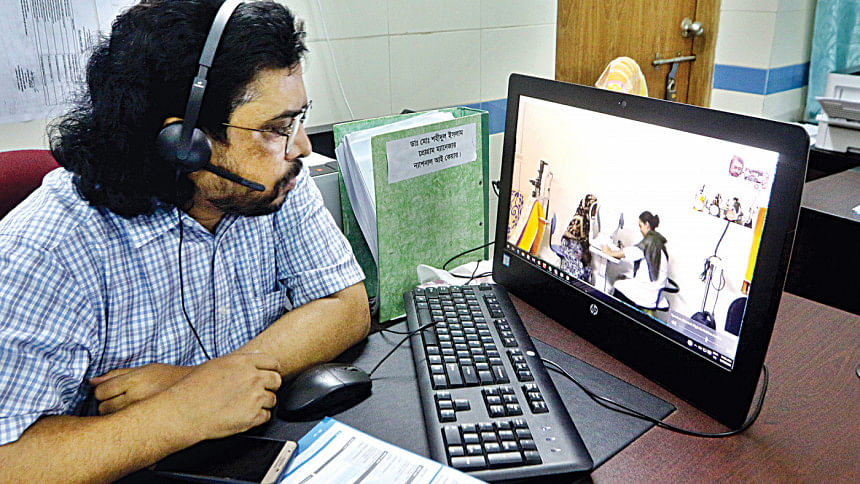Checking eyes from miles away

Samira Begum’s eyes were itchy and watery for a few days when she finally decided to get a check-up at the Puthia Upazila Health Complex of Rajshahi on September 17.
In a room at the healthcare centre sat senior staff nurse Amena Begum who took some readings like eye pressure and blood pressure and entered the data in a software.
Mahbube Habiba Kabita, an ophthalmologist, sitting behind another computer miles away at Rajshahi Medical College Hospital (RMCH) looked at the records, talked to the patient and prescribed treatment accordingly.
In no time, the nurse handed her some free medicines and Samira was out the door with a printed prescription that had an electronic signature of the doctor.
The service was made available three months back when a room at the upazila health complex was equipped to function as a community vision centre, one of 50 units already set up under the National Eye Care plan of the health and family welfare ministry.
The plan was developed and signed by the health ministry in 2005 to meet the nation’s obligation as a signatory of a global campaign to eliminate avoidable blindness by 2020.
The community vision centre programme is, however, very recent; it was included in the plan only a year and half ago, said Golam Mostafa, director at National Institute of Ophthalmology and Hospital (NIOH), which is implementing it.
It was undertaken to take services to the doorsteps of people like Samira by building an eye-care network with 200 community vision centres on the periphery. They will be connected to base centres at tertiary public hospitals or district sadar hospitals, where doctors will prescribe treatment.
Until now, RMCH saw 15 centres in as many upazilas connected to it and in operation.
Another 15 such set-ups are functioning under Rangpur Medical College Hospital as the base centre and 20 under Sheikh Fazilatunnessa Mujib Eye Hospital and Training Institute in Gopalganj.
The eye care network is a replication of Aravind Eye Hospitals, a hospital chain having major contribution to eradicating cataract-related blindness in India.
Aravind Eye Care System is providing technological support and training under a memorandum of understanding signed with the government, said M Zahirul Islam, director research and training at the NIOH.
At every vision centre, two senior staff nurses have been posted from the respective upazila health complexes upon completing four-months of training. They are trained to give spectacles and to measure some parameters. If they come across complicated cases, they have to refer them to the base centres.
The patients referred will be given a card with a code, doctor’s name and the location where s/he has to go.
Many people have already begun making use of the services. In Puthia, about 1,000 patients and in Gopalganj, nearly 1,300 patients received treatment between July 1 and September 17.
And 120 people were referred to Sheikh Fazilatunnessa Mujib Eye Hospital during the same time.
A close monitoring is in place, said Zahirul, as he was communicating from the NIOH with Amena Begum in Puthia through the social media and checking inputs from different centres on September 17.
“We can see everything from here -- who are prescribed what medicines, for what symptoms, and the status of drug stock.”
With all these, vision centres seem to be a reality of a well-thought-out programme but it also faces a few challenges. Uninterrupted internet connection, quick fixing of any instrument and strong opposition from doctors’ community are a few among them, added Zahirul.
The latest available data of national blindness and low vision survey 2003 points to the necessity of a decentralised eye-care system to bridge the gap as 80 percent patients who suffered from blindness that is treatable, low vision or blurred images were living in rural areas and 90 percent of the doctors who could provide them with treatment lived in cities or towns.
Zahirul said doctors at district level were still scarce, let alone at upazilas.
This is the scenario when technology is probably showing the way as to how best the government can overcome the challenges of manpower, resources and distance to reach people living in the furthest corner of the country.

 For all latest news, follow The Daily Star's Google News channel.
For all latest news, follow The Daily Star's Google News channel. 



Comments